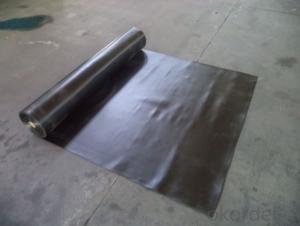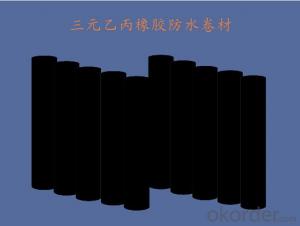Roof EPDM Waterproofing Membrane Width from 1.2mm to 2mm
- Loading Port:
- Qingdao
- Payment Terms:
- TT OR LC
- Min Order Qty:
- 2000 m²
- Supply Capability:
- 100000 m²/month
OKorder Service Pledge
OKorder Financial Service
You Might Also Like
EPDM waterproofing membrane
1. Brief Introduction:
This waterproof membrane is made from ternary ethylene-propylene rubber. Weadopts the world advanced equipment of cold feeding extrusion and continuous valcanization technology.
With the best performance among high polymer waterproof materials, EPDM is of exceptional elasticity and will not split or crack under normal building movement.
2. Characters:
1)Good flexibility, creep properties and malleability, and the superior adapting ability to the deformation of the primary stress generated.
2). Tight adhesion between waterproof layer and basic layer, no channeling water. Having self healing ability after piercing.
3).Operation without heating. And possessing the reliability of pasting by itself with super strong connection of sheet materialand adhesion of same base.
4). Convenient and safe operation, no pollution to the environment.
3. Application:
1),Roofs, Basement, Toilet
2),Industrial and civil building waterproofing
3),Geosynthetic liner for swimming pool, channels, irrigation system
4),Especially suit for projects with high requirements in durability, anti-corrosion anddeformation
4. Package and Storage:
Each Roll with one plastic bag with or without pallets.
Keep in dry and ventilated place. Avoid shining and raining. Height of stack not more than 5 layers. Shelf life:12 months.
5. Specification:
Type | EPDM Waterproof Rubber Membrane | |||
Material | EPDM Rubber | |||
Thickness | 1.0mm | 1.2mm | 1.5mm | 2.0mm |
Size | 1.2m(width) * 20m(length)/roll | |||
Type | Vulcanized | |||
Pattern | Non-reinforced(homogeneous) | |||
Packing | 24sqm--80sqm/roll, with plastic bag | |||
Color | Black | |||
Application | Roofs, basement, pond, Lake, steel structure roof, swimming pool, underground, tunnel, etc | |||
5. Some photos:
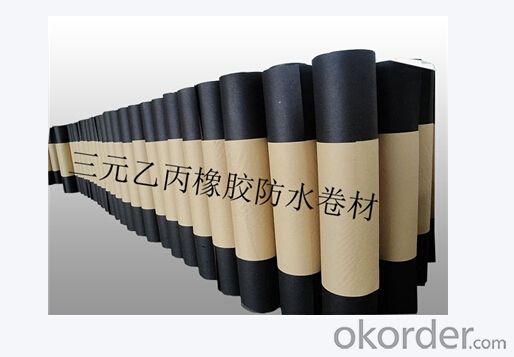
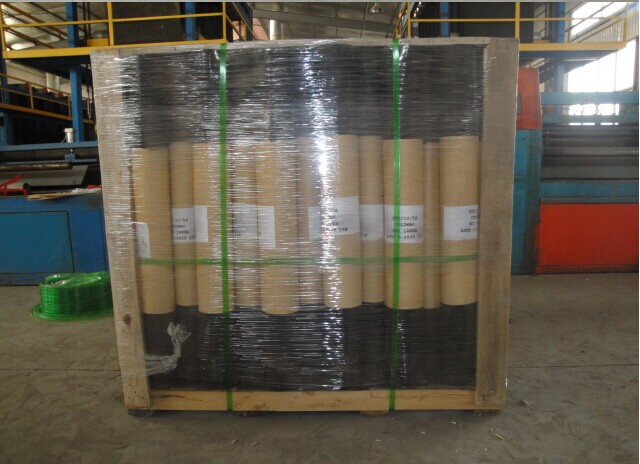
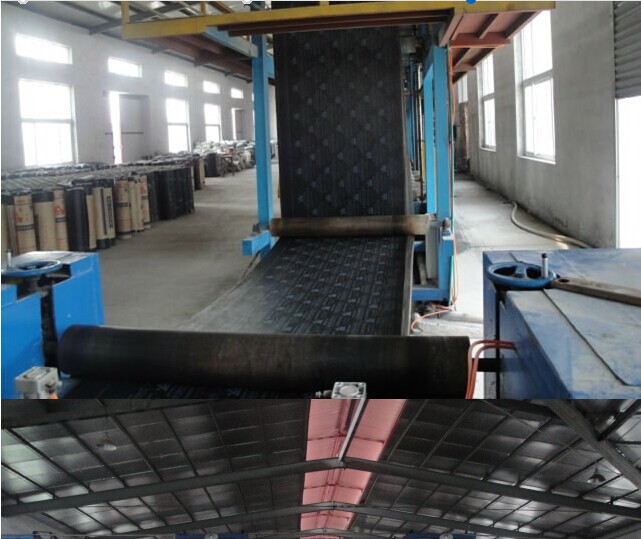

- Q:Are there any specific considerations for installing a waterproofing membrane on precast concrete surfaces?
- Installing a waterproofing membrane on precast concrete surfaces requires specific considerations. Here are some important points to remember: 1. Proper Surface Preparation: Before applying the waterproofing membrane, it is crucial to prepare the precast concrete surface correctly. This involves cleaning the surface, removing loose particles, and ensuring it is dry and free from any contaminants. 2. Compatibility: It is important to select a waterproofing membrane that is suitable for precast concrete surfaces. Some membranes may not adhere well or provide effective waterproofing on this type of substrate. Therefore, it is essential to choose a membrane specifically designed for use on precast concrete. 3. Ensuring Adhesion: Properly adhering the waterproofing membrane to the precast concrete surface is vital. It is important to carefully follow the manufacturer's instructions, including any surface priming or preparation requirements for optimal adhesion. Proper adhesion will prevent water infiltration and concrete damage. 4. Joint Treatment: Precast concrete surfaces often have joints between panels or components. These joints need proper treatment to maintain the system's waterproofing integrity. This may involve using joint sealants or tapes designed specifically for waterproofing purposes. 5. Considering Durability: Consider the durability and longevity of the waterproofing membrane. Precast concrete surfaces are exposed to various weather conditions and environmental factors. Therefore, it is crucial to choose a membrane that can withstand these conditions and provide long-term protection against water penetration. 6. Quality Assurance: It is recommended to work with experienced professionals or certified installers to ensure the proper installation of the waterproofing membrane on precast concrete surfaces. This minimizes the risk of installation errors and ensures that the waterproofing system performs as intended. By considering these factors, installing a waterproofing membrane on precast concrete surfaces can effectively protect the concrete from water damage and extend its lifespan.
- Q:Are waterproofing membranes suitable for stadium structures?
- Yes, waterproofing membranes are suitable for stadium structures. Stadiums are exposed to various weather conditions such as rain, snow, and humidity, which can potentially damage the structure if proper waterproofing measures are not taken. Waterproofing membranes provide a protective layer that prevents water infiltration, thus safeguarding the stadium from moisture-related issues like leaks, mold, and corrosion. Stadium structures often have large roof areas and expansive seating areas where water can accumulate, making waterproofing crucial. Membranes can be applied on various surfaces, including concrete, metal, and wood, ensuring a versatile and effective waterproofing solution for stadiums. Moreover, waterproofing membranes offer durability and longevity, which is essential for stadiums that are subjected to heavy usage and constant exposure to the elements. They are designed to withstand thermal expansion and contraction, as well as UV radiation, ensuring long-term protection for the structure. Additionally, waterproofing membranes can be customized to meet specific design requirements, allowing architects and engineers to integrate them seamlessly into the stadium's overall aesthetic. These membranes come in various colors, textures, and finishes, enabling them to blend with the surrounding materials and enhance the visual appeal of the stadium. Overall, waterproofing membranes provide a reliable and effective solution for protecting stadium structures from water damage. They offer durability, versatility, and customization options, making them suitable for any stadium construction or renovation project.
- Q:Can waterproofing membranes be used on outdoor decks?
- Yes, waterproofing membranes can be used on outdoor decks. Waterproofing membranes are a popular choice for outdoor decks as they provide an effective barrier against moisture, preventing water from seeping through and causing damage to the underlying structure. These membranes are typically made of durable materials such as rubber or PVC and are designed to withstand exposure to the elements. They are applied directly onto the deck surface, creating a waterproof seal that protects the deck from rain, snow, and other forms of moisture. Additionally, waterproofing membranes can also help to prolong the lifespan of the deck by preventing water damage, rot, and decay. Therefore, using waterproofing membranes on outdoor decks is a practical and effective solution for maintaining the integrity and longevity of the deck.
- Q:Can a waterproofing membrane be used in tunnels or underground structures?
- Yes, a waterproofing membrane can definitely be used in tunnels or underground structures. In fact, it is highly recommended to use a waterproofing membrane in these types of environments to prevent water damage and leakage. Tunnels and underground structures are particularly prone to water infiltration due to their location and exposure to underground water sources. The waterproofing membrane acts as a protective barrier, preventing water from seeping into the tunnels or structures and causing potential structural damage or compromising the safety of the space. It effectively creates a watertight seal, ensuring that the interior remains dry and free from water-related issues such as mold, corrosion, or degradation of materials. Additionally, waterproofing membranes are designed to withstand the unique challenges of underground environments such as high water pressure, ground movement, and exposure to harsh chemicals. Therefore, using a waterproofing membrane is not only possible but essential for maintaining the longevity and integrity of tunnels and underground structures.
- Q:Can a waterproofing membrane be used on glass surfaces?
- No, a waterproofing membrane cannot be used on glass surfaces. Waterproofing membranes are typically designed to adhere to porous and rough surfaces such as concrete, wood, or metal. Glass surfaces are smooth and non-porous, which makes it difficult for a membrane to adhere properly and provide a waterproof barrier. Additionally, glass is already naturally waterproof, so there is generally no need for additional waterproofing measures on glass surfaces.
- Q:How does a waterproofing membrane handle hydrostatic pressure?
- A waterproofing membrane handles hydrostatic pressure by acting as a barrier between water and the structure it is applied to. When exposed to hydrostatic pressure, which is the pressure exerted by standing or moving water, the membrane forms a continuous seal that prevents water from penetrating into the structure. The membrane is designed to be impermeable, meaning that it does not allow water molecules to pass through it. It is typically made of materials such as rubber, PVC, or bitumen that have high resistance to water penetration. These materials are also flexible, allowing the membrane to conform to the contours of the surface it is applied to and provide a tight seal. When hydrostatic pressure is applied to the membrane, it resists the force and prevents water from infiltrating the structure. The membrane's resistance to water pressure is a result of its thickness, strength, and the quality of its installation. Thicker membranes are generally more resistant to hydrostatic pressure, while a properly installed membrane with no gaps, voids, or overlaps enhances its effectiveness in handling water pressure. In addition to providing a barrier against water penetration, some waterproofing membranes are also designed to accommodate movement caused by hydrostatic pressure. They can stretch or elongate to accommodate the expansion and contraction of the structure due to varying water levels or other external forces. This flexibility helps the membrane maintain its integrity and prevent water from seeping through. Overall, a waterproofing membrane effectively handles hydrostatic pressure by providing a continuous, impermeable barrier that resists the force of standing or moving water and prevents it from infiltrating the structure. Its ability to withstand water pressure is dependent on its thickness, strength, installation quality, and flexibility to accommodate movement.
- Q:Are waterproofing membranes resistant to chemical spills?
- Yes, waterproofing membranes are typically resistant to chemical spills. These membranes are designed to create a barrier that prevents water and other liquids from penetrating into the underlying structure or substrate. In order to provide this protection, waterproofing membranes are often made from chemically resistant materials, such as synthetic rubber, thermoplastic, or modified bitumen. These materials are chosen for their ability to withstand exposure to a wide range of chemicals, including oils, solvents, acids, and alkalis. However, it is important to note that the specific chemical resistance of a waterproofing membrane may vary depending on the materials used and the manufacturing process. Therefore, it is necessary to consult the manufacturer's guidelines or specifications to ensure that the chosen waterproofing membrane is suitable for the intended chemical environment.
- Q:What type of maintenance is required for a waterproofing membrane?
- To properly maintain a waterproofing membrane, regular inspections and routine maintenance are necessary. Firstly, it is important to keep the surface clean and free from debris that could potentially damage the membrane. Regularly remove any dirt, leaves, or other foreign materials that may accumulate on the surface. Inspect the membrane for any signs of wear, tear, or damage, such as cracks, blisters, or punctures. If any issues are found, they should be repaired promptly to prevent water leakage and potential further damage. Additionally, it is recommended to inspect and maintain the surrounding areas of the membrane, including gutters, downspouts, and drainage systems. Ensure that these components are functioning properly and free from any blockages that could compromise the effectiveness of the waterproofing system. Depending on the type of waterproofing membrane used, it may require periodic reapplication of a protective coating or sealant. This will help to extend the lifespan of the membrane and ensure its continued effectiveness. It is also essential to monitor the membrane's performance during heavy rain or snow events. Check for any signs of water pooling or leakage, and address any problems promptly. Overall, regular inspections, routine cleaning, prompt repairs, and necessary reapplication of protective coatings are key maintenance tasks to ensure the longevity and effectiveness of a waterproofing membrane.
- Q:Can a waterproofing membrane be used on precast stone surfaces?
- Yes, a waterproofing membrane can be used on precast stone surfaces. Precast stone surfaces, like any other concrete or masonry surfaces, are susceptible to water infiltration, which can cause damage over time. Applying a waterproofing membrane on the precast stone surface can help prevent water penetration and protect the stone from moisture-related issues such as cracking, spalling, and efflorescence. The membrane forms a barrier that blocks water from seeping into the stone while still allowing it to breathe and release any trapped moisture. It is important to choose a waterproofing membrane that is compatible with the precast stone material and follow the manufacturer's instructions for proper application.
- Q:Can a waterproofing membrane be used in agricultural structures?
- In agricultural structures, like barns, greenhouses, and storage facilities, it is possible to utilize a waterproofing membrane. These structures often necessitate protection against moisture and water harm. A waterproofing membrane is a robust and flexible substance that can be applied to diverse surfaces such as roofs, walls, and floors to obstruct water infiltration. It functions as a barrier, stopping water from penetrating the structure and causing destruction to the building materials, equipment, and stored crops. Moreover, a waterproofing membrane can also assist in regulating the temperature and humidity levels within the agricultural structure, generating a more controlled and ideal environment for crops, livestock, and equipment. In summary, the utilization of a waterproofing membrane in agricultural structures can guarantee the durability and functionality of the building while safeguarding the valuable assets inside.
1. Manufacturer Overview |
|
|---|---|
| Location | |
| Year Established | |
| Annual Output Value | |
| Main Markets | |
| Company Certifications | |
2. Manufacturer Certificates |
|
|---|---|
| a) Certification Name | |
| Range | |
| Reference | |
| Validity Period | |
3. Manufacturer Capability |
|
|---|---|
| a)Trade Capacity | |
| Nearest Port | |
| Export Percentage | |
| No.of Employees in Trade Department | |
| Language Spoken: | |
| b)Factory Information | |
| Factory Size: | |
| No. of Production Lines | |
| Contract Manufacturing | |
| Product Price Range | |
Send your message to us
Roof EPDM Waterproofing Membrane Width from 1.2mm to 2mm
- Loading Port:
- Qingdao
- Payment Terms:
- TT OR LC
- Min Order Qty:
- 2000 m²
- Supply Capability:
- 100000 m²/month
OKorder Service Pledge
OKorder Financial Service
Similar products
New products
Hot products
Related keywords


